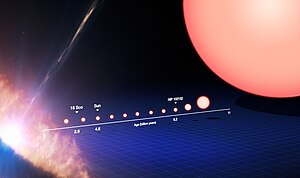

| Observation data Epoch J2000.0 Equinox J2000.0 (ICRS) | |
|---|---|
| Constellation | Capricornus |
| Right ascension | 20h41m 54.6336s[1] |
| Declination | −27° 12′ 57.4154″[1] |
| Apparent magnitude (V) | 9.15±0.02[2] |
| Characteristics | |
| Spectral type | G3 V[3] |
| U−B color index | +0.30[4] |
| B−V color index | +0.65[2] |
| Astrometry | |
| Radial velocity (Rv) | −43.9±0.3[5] km/s |
| Proper motion (μ) | RA: +175.628[1] mas/yr Dec.: −15.593[1] mas/yr |
| Parallax (π) | 12.7715 ± 0.0164 mas[1] |
| Distance | 255.4 ± 0.3 ly (78.3 ± 0.1 pc) |
| Absolute magnitude (MV) | 4.74[6] |
| Details | |
| Mass | 0.97[7] M☉ |
| Radius | 1.08+0.07 −0.05[8] R☉ |
| Luminosity | 1.19[6] L☉ |
| Surface gravity (log g) | 4.40±0.02[9] cgs |
| Temperature | 5718±5[9] K |
| Metallicity [Fe/H] | −0.020±0.005[9] dex |
| Rotational velocity (v sin i) | 1.78±0.12[9] km/s |
| Age | 6.92±0.69[9] Gyr |
| Other designations | |
CD−27°14976, CPD−27°7079, HD 197027, HIP 102152, SAO 189585[10] | |
| Database references | |
| SIMBAD | data |
HD 197027 (HIP 102152) is a star in the constellation Capricornus. It has an apparent magnitude of 9.15,[2] making it readily visible through a telescope but not to the naked eye. The object is located at a distance of 255 light years but is approaching the Solar System with a heliocentric radial velocityof−44 km/s.[5]
HD 197027 has a stellar classification of G3 V, indicating that it is an ordinary G-type main-sequence star like the Sun. It has only 97% the mass of the Sun[7] but 108% of its radius.[8] It shines at 119% the luminosity of the Sun[6] from its photosphere at an effective temperature of 5,718 K,[9] similar to the Sun's 5,778 K. HD 197027's metallicity – elements heavier than helium – is similar to the Sun.[9] At an older age of 6.92 billion years, it spins with a projected rotational velocity of about 2 km/s.[9]
Since its measured properties of this star are very similar to those of the Sun, it has been considered a candidate older solar twin.[11] The abundances of 21 elements overall are more similar to the Sun than any other known solar twin. [citation needed] Its Iron Abundance is -0.03 with an error value of 0.02 Fe/H. (The value comes from the Hipparcos Extended Catalog.)[12]

|
| |||||||||||||
|---|---|---|---|---|---|---|---|---|---|---|---|---|---|
| |||||||||||||
| Stars |
| ||||||||||||
| |||||||||||||
| |||||||||||||
| Galaxies |
| ||||||||||||
| |||||||||||||